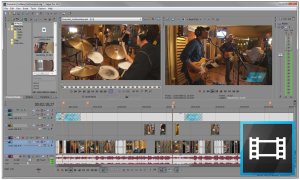 If you are looking for an easy-to-use editing application that’s optimized for a Windows workstation, one option is the Vegas Pro family from Sony Creative Software. There are several configurations, including Vegas Pro 13 Edit, Vegas Pro 13 and Vegas Pro 13 Suite. The big differences among these is the selection of Sony and third party tools that come with the bundle. The Edit version is mainly the NLE software. The standard Vegas Pro 13 package includes a Dolby Digital Professional encoder, DVD Architect Pro 6, the NewBlueFX Video Essentials VI plug-in collection and Nectar Elements from iZotope. All three products include CALM Act-compliant loudness metering and the HitFilm video plug-in collection from FXHOME. The Suite bundle adds Sound Forge Pro 11 (a file-based audio editor), HitFilm 2 Ultimate (a separate compositing application), Vegas Pro Production Assistant and 25 royalty-free music tracks.
If you are looking for an easy-to-use editing application that’s optimized for a Windows workstation, one option is the Vegas Pro family from Sony Creative Software. There are several configurations, including Vegas Pro 13 Edit, Vegas Pro 13 and Vegas Pro 13 Suite. The big differences among these is the selection of Sony and third party tools that come with the bundle. The Edit version is mainly the NLE software. The standard Vegas Pro 13 package includes a Dolby Digital Professional encoder, DVD Architect Pro 6, the NewBlueFX Video Essentials VI plug-in collection and Nectar Elements from iZotope. All three products include CALM Act-compliant loudness metering and the HitFilm video plug-in collection from FXHOME. The Suite bundle adds Sound Forge Pro 11 (a file-based audio editor), HitFilm 2 Ultimate (a separate compositing application), Vegas Pro Production Assistant and 25 royalty-free music tracks.
Vegas Pro is a 64-bit application that requires a 64-bit version of Windows 7, 8 or 8.1. In my testing, I installed it on a Xeon-powered HP Z1 G2 configured with Windows 8.1, an NVIDIA K4100m GPU and 16GB of RAM. I didn’t have any video I/O device connected, so I wasn’t able to test that, but Vegas Pro will support AJA hardware and various external control surfaces. If you’ve ever used a version of Vegas Pro in the past, then Vegas Pro 13 will feel comfortable. For those who’ve never used it, the layout might be a bit of a surprise compared with other NLE software. Vegas is definitely a niche product in the market, in spite of its power, but fans of the software are as loyal to it, as those on the Mac side who love Final Cut Pro X.
Vegas Pro 13 supports a wide range of I-frame and long-GOP video codecs, including many professional and consumer media formats. For those moving into 4K, Vegas Pro 13 supports XAVC (used by the F55) and XAVC-S, a format used in Sony’s 4K prosumer cameras. Other common professional formats supported include Panasonic P2 (AVC-Intra), Sony XDCAM, HDCAM-SR, ProRes (requires ProRes for Windows and QuickTime installed) and REDCODE raw. 4K timeline support goes up to a frame size of 4096 x 4096 pixels. As an application with deep roots in audio, the list naturally includes most audio formats, as well.
What’s new
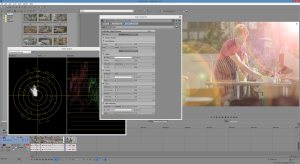 Fans of Vegas Pro will find a lot in version 13 to justify an upgrade. One item is Vegas Pro Connect, an iPad companion application designed to be used for review and approval. It features an online and offline mode to review and add comments to a Vegas Pro project. There’s also a new “proxy-first” workflow. For example, videographers shooting XDCAM can use the Sony Wireless Adapter to send camera proxies to the cloud. While the XDCAM discs are being shipped back to the facility, the editors can download and start the edit with the proxies. When the high-resolution media arrives, they then automatically relink the project to this media. Vegas Pro 13 adds a project archive to back up projects and associated media.
Fans of Vegas Pro will find a lot in version 13 to justify an upgrade. One item is Vegas Pro Connect, an iPad companion application designed to be used for review and approval. It features an online and offline mode to review and add comments to a Vegas Pro project. There’s also a new “proxy-first” workflow. For example, videographers shooting XDCAM can use the Sony Wireless Adapter to send camera proxies to the cloud. While the XDCAM discs are being shipped back to the facility, the editors can download and start the edit with the proxies. When the high-resolution media arrives, they then automatically relink the project to this media. Vegas Pro 13 adds a project archive to back up projects and associated media.
 The plug-ins have been expanded in this release by bundling in new effects from NewBlueFX, FXHOME and iZotope. The video effects include color modification, keying, bleach bypass, light flares, TV damage and a number of other popular looks. These additions augment Vegas Pro’s extensive selection of Sony audio and video effects. Vegas supports the VST audio plug-in and OpenFX (OFX) video plug-in formats. This means other compatible plug-ins installed for other applications on your system can be detected and used. For example, The FXHOME HitFilm plug-ins also showed up in Resolve 11 Lite (beta) that I had installed on this computer, because both applications share the OFX architecture.
The plug-ins have been expanded in this release by bundling in new effects from NewBlueFX, FXHOME and iZotope. The video effects include color modification, keying, bleach bypass, light flares, TV damage and a number of other popular looks. These additions augment Vegas Pro’s extensive selection of Sony audio and video effects. Vegas supports the VST audio plug-in and OpenFX (OFX) video plug-in formats. This means other compatible plug-ins installed for other applications on your system can be detected and used. For example, The FXHOME HitFilm plug-ins also showed up in Resolve 11 Lite (beta) that I had installed on this computer, because both applications share the OFX architecture.
Given its audio heritage, Vegas Pro 13 includes a comprehensive audio mixer. New with this release is the inclusion of iZotope Nectar Elements, a single audio plug-in designed for one-click voice processing. Another welcome addition is a loudness meter window to measure levels and mixes in order to be compliant with the CALM Act and EBU R-128.
Putting Vegas Pro 13 through the paces
 One big selling point of version 13 is GPU acceleration based on OpenCL in NVIDIA, AMD and Intel graphics cards. This becomes especially important when dealing with 4K formats. The performance advances are most noticeable once you start layering video tracks. Certainly working with 4K XAVC, RED EPIC Dragon and 1080p ProRes 4444 media was easy. Scrubbing and real-time playback never caused any issues. The Vegas Pro preview window lets you manually or automatically adjust visual preview quality to maintain maximum real-time playback. If you are a RED user, then you’ll appreciate access to the R3D decode properties. The Z1 G2 felt very responsive working with native RED camera media.
One big selling point of version 13 is GPU acceleration based on OpenCL in NVIDIA, AMD and Intel graphics cards. This becomes especially important when dealing with 4K formats. The performance advances are most noticeable once you start layering video tracks. Certainly working with 4K XAVC, RED EPIC Dragon and 1080p ProRes 4444 media was easy. Scrubbing and real-time playback never caused any issues. The Vegas Pro preview window lets you manually or automatically adjust visual preview quality to maintain maximum real-time playback. If you are a RED user, then you’ll appreciate access to the R3D decode properties. The Z1 G2 felt very responsive working with native RED camera media.
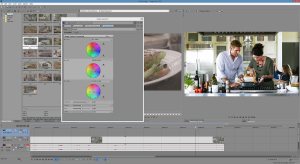 Many editors take awhile to get comfortable with Vegas Pro’s interface. Vegas started life as a multi-track audio software (DAW) and the layout and track design stems from that. Each video and audio track is designed like a mixing board channel strip. You have a read/touch/latch automation control, a plug-in chain and a level slider. With audio you also get panning and a meter. With video, you get a spatial control, parent/child track hierarchy control (for track grouping) and a compositing mode. Many of the functions can be manipulated in real-time, while the timeline is playing. This may seem obvious when writing audio levels in an automated mixing pass. It’s more unique for video. For example, you can do the same for video opacity – writing a real-time pass of opacity level changes on-the-fly, simply by adjusting the video level fader as the timeline plays.
Many editors take awhile to get comfortable with Vegas Pro’s interface. Vegas started life as a multi-track audio software (DAW) and the layout and track design stems from that. Each video and audio track is designed like a mixing board channel strip. You have a read/touch/latch automation control, a plug-in chain and a level slider. With audio you also get panning and a meter. With video, you get a spatial control, parent/child track hierarchy control (for track grouping) and a compositing mode. Many of the functions can be manipulated in real-time, while the timeline is playing. This may seem obvious when writing audio levels in an automated mixing pass. It’s more unique for video. For example, you can do the same for video opacity – writing a real-time pass of opacity level changes on-the-fly, simply by adjusting the video level fader as the timeline plays.
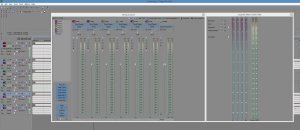 Once you get deeper into Vegas, you’ll find quite a few surprises. For example, it supports stereoscopic workflows. The Title Generator effects include numerous animated text templates. Together with DVD Architect, you have a solid Blu-Ray Disc authoring system. Unfortunately, there were also a few things I’d wanted to test that simply didn’t seem to work. Vegas Pro 13 is supposed to be able to import and export a range of project files, including XML, AAF, FCPXML, Premiere projects, etc. I attempted to import XML, FCPXML and Premiere Pro project files, but came up empty each time. I was never able to export an FCPXML file. I was able to export FCP 7 XML and Premiere project files, but the Premiere file crashed Premiere Pro CC 2014 on both my Mac and this test PC. The FCP 7 XML did work in Premiere Pro, though. I tried to bring an XML into Final Cut Pro X using the 7toX translation utility, but FCP X was unable to relink to the media files. So, while this should be a great feature, it seems to be a work-in-progress at this point.
Once you get deeper into Vegas, you’ll find quite a few surprises. For example, it supports stereoscopic workflows. The Title Generator effects include numerous animated text templates. Together with DVD Architect, you have a solid Blu-Ray Disc authoring system. Unfortunately, there were also a few things I’d wanted to test that simply didn’t seem to work. Vegas Pro 13 is supposed to be able to import and export a range of project files, including XML, AAF, FCPXML, Premiere projects, etc. I attempted to import XML, FCPXML and Premiere Pro project files, but came up empty each time. I was never able to export an FCPXML file. I was able to export FCP 7 XML and Premiere project files, but the Premiere file crashed Premiere Pro CC 2014 on both my Mac and this test PC. The FCP 7 XML did work in Premiere Pro, though. I tried to bring an XML into Final Cut Pro X using the 7toX translation utility, but FCP X was unable to relink to the media files. So, while this should be a great feature, it seems to be a work-in-progress at this point.
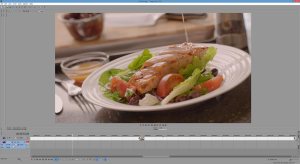 It was hard for me to warm up to the interface itself. While it’s very fast to operate, Vegas Pro is still designed like an audio application, and so, is very different than most traditional NLEs. For example, double-clicking a clip edits it straight to the timeline as the default condition. To first send it to the source viewer in order to select in and out points, you have to use the “Open in Trimmer” command. Fortunately, there is a preference setting to flip this behavior. Vegas Pro projects contain only a single timeline – also referred to as the project (like in FCP X). You cannot have multiple timelines within a single production, however, you can have more than one instance of Vegas Pro open at the same time. In that case, you can switch between them using the Windows task bar to select which active application window to bring to the front. It is also possible to edit a .veg (Vegas Pro project) file to the timeline. This gives you the same result as in other NLE software, where you can edit a nested timeline into another timeline.
It was hard for me to warm up to the interface itself. While it’s very fast to operate, Vegas Pro is still designed like an audio application, and so, is very different than most traditional NLEs. For example, double-clicking a clip edits it straight to the timeline as the default condition. To first send it to the source viewer in order to select in and out points, you have to use the “Open in Trimmer” command. Fortunately, there is a preference setting to flip this behavior. Vegas Pro projects contain only a single timeline – also referred to as the project (like in FCP X). You cannot have multiple timelines within a single production, however, you can have more than one instance of Vegas Pro open at the same time. In that case, you can switch between them using the Windows task bar to select which active application window to bring to the front. It is also possible to edit a .veg (Vegas Pro project) file to the timeline. This gives you the same result as in other NLE software, where you can edit a nested timeline into another timeline.
Speaking of the interface, the application badly needs a redesign. It looks like it’s still from the Windows 98 world. Some people appreciate starkness – and I know this probably helps the application’s speed – but, if you’re going to stare at a screen all day long, it should look a bit more elegant. Even Sony’s Sound Forge Pro for the Mac, which shares a similar design and starkness, is cleaner and feels more modern. Plus it’s very bright. In fact, disabling the Vegas theme in preferences makes it even painfully brighter. It would be great if Vegas Pro had a UI brightness slider, like Adobe has offered for years.
Conclusion
Sony’s Vegas Pro 13 is a useful application with a lot of power for users at all levels. At only a few hundred dollars, it’s a strong application suite to have in your Windows toolkit, even if you prefer other NLEs. The prime reason is the wide codec support and easy 4K editing. If that’s how you use it, then the interface issues I mentioned won’t be a big deal.
On the other hand, if you’re an experienced Vegas Pro user and happy with it as is, then version 13 is a worthy upgrade, especially on a high-end machine. It’s fast, efficient and gets the job done. If Sony fixes the import/export problems I encountered, Vegas Pro could become a tool that would make itself indispensable.
Originally written for Digital Video magazine / CreativePlanetNetwork.
©2014 Oliver Peters